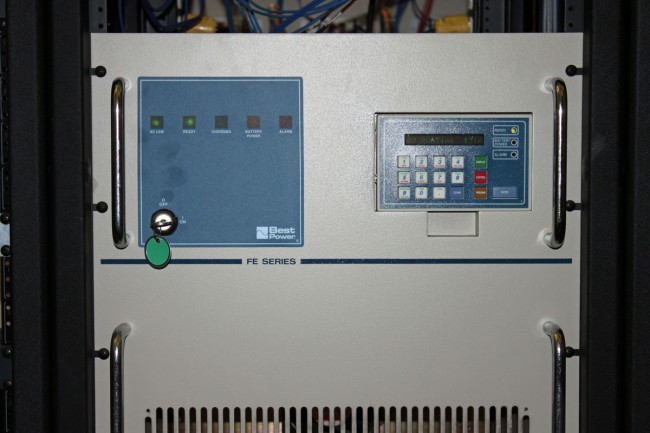A client of ours, WDST in Woodstock, NY, has this Best FE7KVA UPS. This unit is several years old and has already been through a couple of battery replacements. These are good units, however, Best Power has been bought up by Eaton/Powerware and they are no longer made apparently are still made.

Regardless of that, the UPS is still functional, but like all UPS’s, it needs battery replacement every so often. This unit has three battery cases, each holding four 75 Ah (20 hour rate) 12 volt sealed lead acid batteries. Each battery is slightly larger than an average car battery. There is one important detail here, the batteries must be gas recombinant because the UPS has a four stage battery charging system. Gel or AGM batteries will not make it past the first or second equalizing charge.

A bit about batteries and battery charging. Most battery chargers are three stage units; bulk, absorption, and float. The rate of charge depends on the voltage of the battery. Bulk charging sends the most current to the battery and for 12 volt cells, this anything below 12.5 volts or so. Absorption stage reduces the charging current and supplies a steady current until the battery reaches full charge of 13.8 volts or so. Float or trickle charging draws very little current, just enough to maintain the battery at full charge.
The forth stage of charging is equalizing which is important for multiple battery series/parallel installations. This is when the batteries are deliberately overcharged for a period of time. The reason for equalizing charges is to intentionally boil off some hydrogen gas and knock any sulfur crystals off of the lead plates. With multiple battery banks in a parallel configuration, it is important to maintain the battery resistances as close as possible so that each bank of batteries is drawn on and charged equally.
In flooded lead acid batteries, this works well and the battery either vents off the hydrogen gas or recombines it will oxygen to make water again. In non-gas recombinant cells, the hydrogen will be released into the room which may pose an explosion hazard. Additionally, the electrolyte level will need to be checked after every equalization charge. With a sealed non-recombinant battery, the case my bulge and split, spilling electrolyte and ruining the battery and battery enclosure. Thus the importance of ordering the correct replacement batteries.

After all, the reason for the UPS is to protect the expensive computer equipment connected to it. It simply will not do to install the wrong stuff and do more damage than if the UPS did not exist at all.






Eaton does indeed still make and sell the FerrUPS series. Not cheap, but well worth the protection. Depending on how old your unit is, they might suggest replacing it, as there probably have been some firmware improvements. However it might be more economical to convert to a handful of smaller UPSes, so if one goes down you don’t lose everything. That way you can also use the more commonly available AGM gel-type batteries that usually last 3 years. Not all units will tell you when the batteries need replacing, and many will just sit there boiling the electrolyte out of the batteries until they crack and swell and can’t be removed without a crowbar (been there, done that with just about every APC UPS I’ve run across).
Also, if you do get something new, make sure it’s a full on-line unit that runs the load on the inverter 100% of the time, without a relay switching the load. Much better protection, especially for computers that often reboot at the slightest glitch, such as when a tree falls on the power lines and causes the voltage to go nuts for several seconds, during which time the UPS switches between AC and battery, often confusing the loads to the point that they either shut down or reboot.
And make sure it will run on a generator that could have an output frequency of 55-65 Hz; some units are picky about the incoming power and will switch to battery if it’s not within 0.1 Hz (TripLite, for example).
Bob M.
Had good experiences with both Best and later Eaton UPSes, very high quality and happily very trouble free though very expensive and very heavy. Found large PVC pipe fittings to excellent for holding up the rear of these when mounting at the bottom of racks, they are never supplied with rack rail mountings
Yes, they are still made and appear to be unchanged from the originals. There is nothing better than the heavy iron of a ferro-resonant transformer to keep the nastys away from your equipment. The trade off is that they are big and weigh a lot more that a double conversion design.
I’ve seen many of the APC brand UPSes in us at various facilities I work at and their biggest flaw seems to be most won’t operate / charge under generator power. I’ve also had colleagues tell me the Staco units have worked quite well in their installations.
The biggest challenge I’ve found is environmental control where the UPS is located. Overly hot rooms seem to drive batteries into the disaster zone, prematurely failing and often bulging to the point where total disassembly of either the trays or UPS itself is required for replacement.
They are indeed still made. I don’t know why I didn’t find them on the Eaton Powerware site the first time I looked. We have several of these units installed running from 1KVA all the way up to 18 KVA and they do the job well.
Heat does indeed kill batteries, I think the rule of thumb is for every 10 degrees above 80 degree F ambient temperature reduces the battery life by 15%.
Many generators/UPS’s do not get along. If one is planning a facility, a PMG excited generator is the best option for powering a UPS.
The APC SmartUPS units have a sensitivity adjust pushbutton and LED on the back that will help them run better when on a generator. The default is maximum sensitivity and brightest LED; at that setting they will complain continuously if the power is not absolutely perfect.
Some TripLite on-line units have similarly tight voltage and frequency requirements. I once argued with their tech support about why their units should care about the quality of the incoming power when it’s just being used to charge the battery and power the inverter, something that should work fine on anything from about DC to several thousand Hertz. Their argument was that the incoming power had to be perfect for the unit to use it, otherwise it goes to battery and ignores the incoming AC. And of course, once the battery power has been all used up, the unit has no choice but to switch back to AC, good or bad, or shut off completely, therefore offering no protection at all.
I have a much older Best Fortress that also was unhappy with generator power, but a call to Eaton and 15 minutes pushing buttons to change some hidden parameters seems to have desensitized that unit.
My Liebert GXT-2 will decide whether to operate at 50 or 60 Hz depending on the input power frequency; the decision point is 55 Hz. But you can also force it to run at either frequency irregardless of the incoming power. The unit also could care less about the incoming power since it’s mainly used to charge the batteries and run the inverter when it’s present.
Bob M.
I’ve found that APC UPSs are very hard on batteries and have the cheapest inverters. I don’t recommend them; I’ve seen several that the batteries could not be removed from without irreversible dis-assembly. When the transistor blows before the fuse, you know something is designed incorrectly.
SmartUPS = Sine, BackUPS = Square wave.